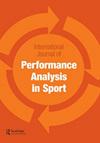模拟两项对训练有素的铁人三项运动员多段跑内外负荷的影响
IF 1.6
4区 教育学
Q1 Health Professions
International Journal of Performance Analysis in Sport
Pub Date : 2023-01-02
DOI:10.1080/24748668.2023.2185744
引用次数: 0
摘要
摘要两项全能是一项快速发展的运动,因此有必要找出影响成绩的因素。本研究旨在分析两项全能自行车前后跑腿过程中的内外载荷及其相互作用。23名男女运动员参加了一项模拟两项比赛(5k-20k-5k)。使用感知用力率(RPE)和心率(最大值:HRMAX;平均值:HRAVG;R-R间期)评估内部工作量,而使用连接在六个身体位置的惯性传感器(RealTrack的玩家负载,PLRT)评估外部工作量。结果显示,在整个公里数中,两个跑步腿的RPE、HRMAX和HRAVG都呈增加趋势,而R–R间隔则有所减少。上下背部、膝盖和脚踝的PLRT在第一次跑步中增加,但在第二次跑步中没有增加。由于能量吸收,下半身的PLRT大于上半身。第二跑腿的RPE高于第一跑腿。总之,在两项全能比赛中,自行车腿会影响跑腿之间的内外负荷。负荷监测可以帮助教练了解两项全能运动员的表现,并设计具体的训练策略来减少比赛中的疲劳。本文章由计算机程序翻译,如有差异,请以英文原文为准。
The effects of simulated duathlon on multisegment running external and internal load in well-trained triathletes
ABSTRACT Duathlon is a rapidly promoting sport, so it is necessary to identify the factors that influence performance. This study aimed to analyse internal and external loads and the interactions between them during running legs before and after cycling in duathlon. Twenty-three male and female athletes participated in a simulated duathlon (5k-20k-5k). Internal workload was assessed using the rate of perceived exertion (RPE) and heart rate (maximum: HRMAX; average: HRAVG; R-R interval), whereas external workload was assessed using inertial sensors (Player Load by RealTrack, PLRT) attached to six body locations. The results showed that both running legs presented an increasing trend in RPE, HRMAX, and HRAVG throughout the kilometres, while the R–R interval decreased. The PLRT of the upper and lower back, knee, and ankle increased throughout the first running leg but not in the second. The PLRT was greater in the lower body than in the upper body because of energy absorption. RPE was higher in the second running leg than in the first leg. In conclusion, the cycling leg affects the internal and external load between running legs in duathlon. Load monitoring can help coaches understand duathletes’ performance and design specific training strategies to reduce fatigue during competition.
求助全文
通过发布文献求助,成功后即可免费获取论文全文。
去求助
来源期刊

International Journal of Performance Analysis in Sport
SPORT SCIENCES-
CiteScore
4.70
自引率
4.80%
发文量
38
审稿时长
>12 weeks
期刊介绍:
The International Journal of Performance Analysis in Sport aims to present current original research into sports performance. In so doing, the journal contributes to our general knowledge of sports performance making findings available to a wide audience of academics and practitioners.
 求助内容:
求助内容: 应助结果提醒方式:
应助结果提醒方式:


